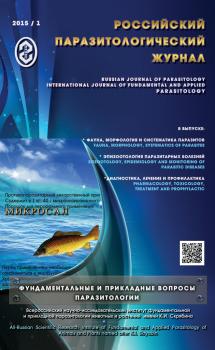In the present study, examination of 442 faecal samples was performed: 171 from cattle, 128 from buffaloes and 143 from sheep. During the period from May, 2014 to April, 2015, fecal examination showed the infection rate with abomasal nematodes was 30% in cattle, 22.6% in buffaloes, and 31.4% in sheep. Fecal culture gave results of 47.5%, 30%, and 50.3% in cattle, buffaloes and sheep respectively. Seasonal infection with abomasal nematodes as shown by faecal culture in cattle, reveals the highest infection rate is in summer (55.9%), followed by spring (54.1%), autumn (50%), and winter (33.3%). Cooperia spp. is the most prevalent larva in both cattle and buffaloes; Strongyloides papillosus is the most predominant one in sheep. Here we introduce the first study of abomasal worms infection in ruminants in Sohag, Egypt. The prevalence is found to be so high among the all examined animals, that we recommend that the authorities apply suitable control programs.
Haemonchus, Ostertagia, seasonal dynamics, floatation.
Introduction
RUMINANTS comprise the greatest portion of animal stock in Egypt’s Sohag province. The gradual growth in the human population with its increased consumption of animal protein has put a strain on the limited current animal production. More research into the problem of animal production is needed (Sultan et al. 2010; Perry et al. 1998; Guirgis 1984 and Hanelein and Abdellatif 2003). The parasitic infections that afflict the animal production industry have great economic impact, especially in developing countries (Sultan, et al. 2010 and Perry et al. 1998). Richard and Zimmerman (1992) investigated the epizoology of gastrointestinal nematodes in selected areas of Oregon, USA. They identified eight nematode genera, among them Ostertagia, Cooperia, Trichostongylus, and Capillaria. Khalaf-Allah (1994) reported that the most common nematodes among cattle and buffaloes in Kalubia governorate were Ostertagia, Haemonchus, Trichostrongyle, and Cooperia. He concluded that nematodes infection was generally more severe in young animals, the infection rate decreasing as the animal ages. Professional livestock production is an important business and anything that adversely affects production will impair the economy, hurting the individual farmer as well as the entire industry (Corwin 1997). The aim of the present work is to investigate gastro-intestinal nematodes that infest ruminants in Sohag province, their incidence, prevalence, and seasonal fluctuation.
1.
2.
3.
4.
5.
6.
7.
8.
9.
10.
11.
12.
13.
14.
15.
16.
17.
18.





